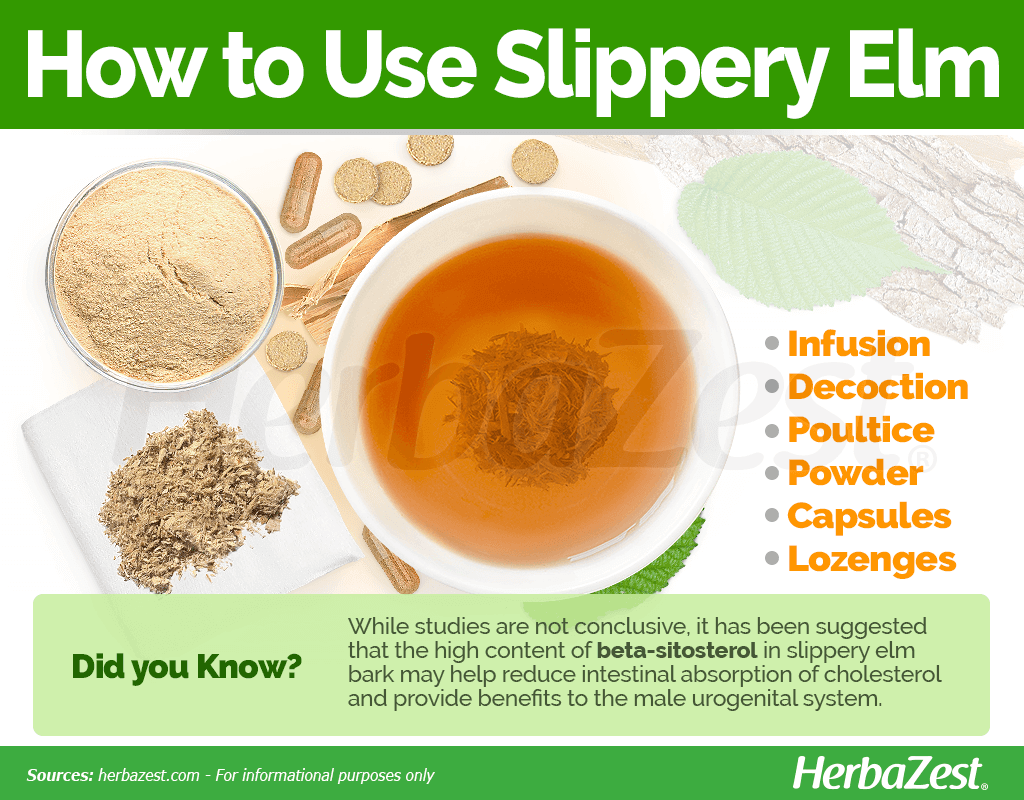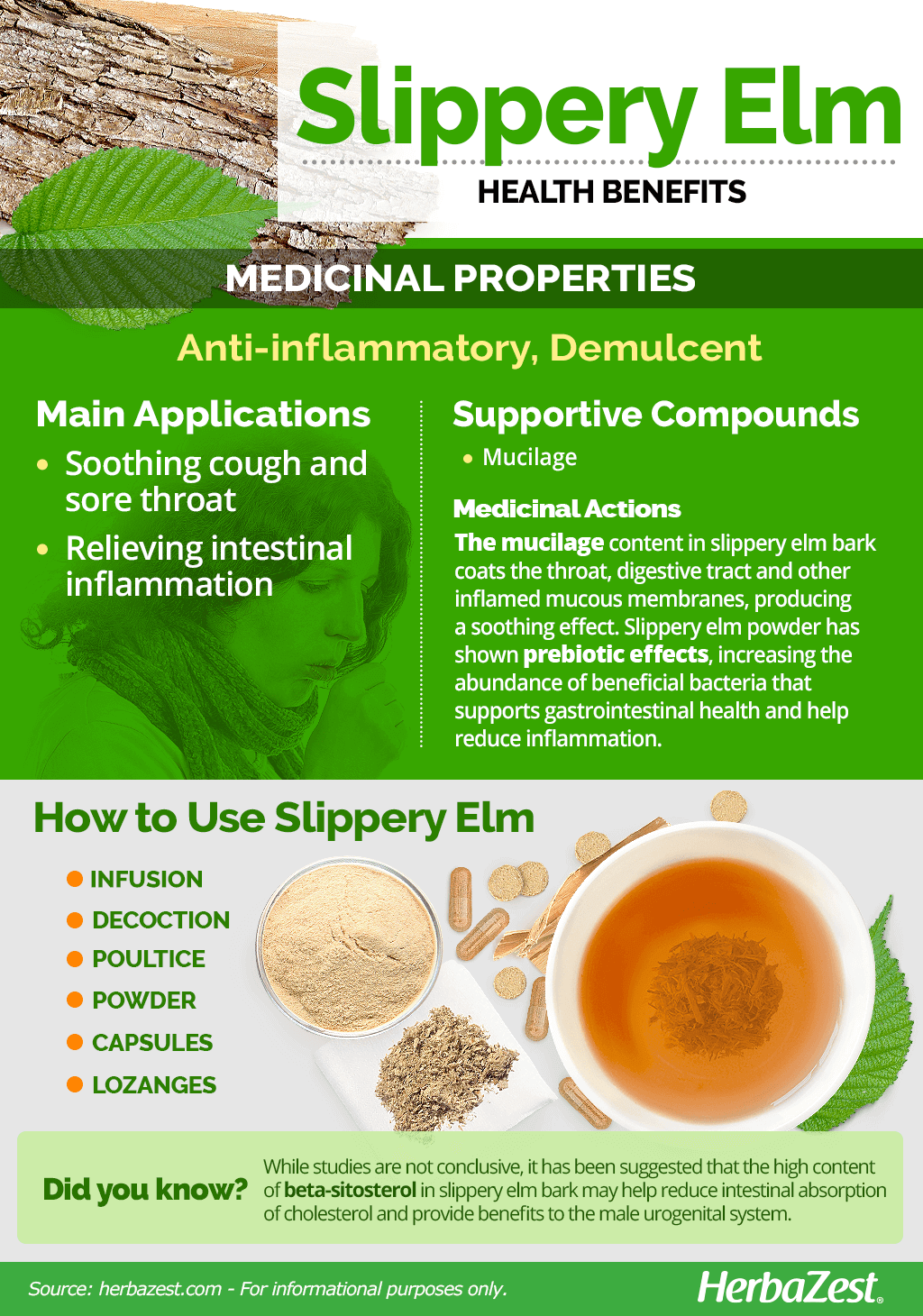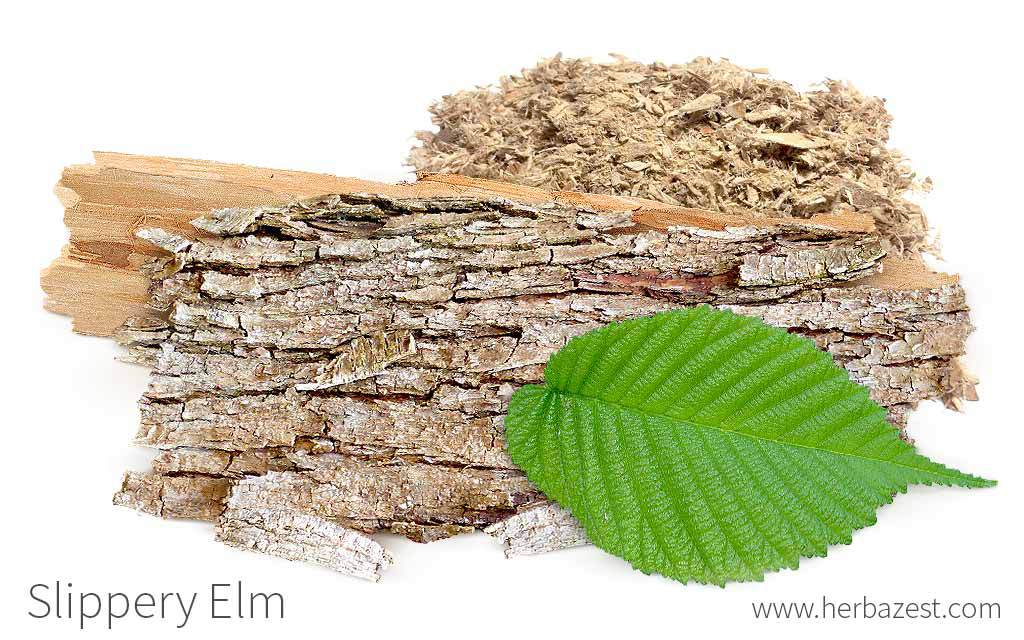Slippery elm, also known as American red elm or red elm tree, is native to North America, where its bark was used for medicinal purposes by aboriginal tribes long before the arrival of the first settlers to the New World. Slippery elm has been traditionally valued for its anti-inflammatory and antiseptic properties, and some of its main uses remain strong today.
Slippery Elm Medicinal Properties
- Medicinal action Anti-inflammatory, Demulcent
- Key constituents Mucilage
- Ways to use Capsules, Hot infusions/tisanes, Poultice
- Medicinal rating (2) Minorly useful plant
- Safety ranking Safe
Health Benefits of Slippery Elm
With both tried-and-true applications and emerging research, slippery elm benefits have been suggested for the following potential medicinal uses:
Soothing sore throat. Arguably the most popular of slippery elm benefits, its analgesic and anti-inflammatory properties help reduce cough and irritation caused by upper respiratory diseases.
Relieving intestinal inflammation. It is thought that the mucilaginous compounds of slippery elm bark have the ability to heal ulcers as well as soothe the discomfort caused by irritable bowel syndrome (IBS) and other digestive disorders
Additionally, slippery elm properties have been traditionally used for lowering cholesterol levels, reducing prostate inflammation, and treating superficial wounds, burns, gout, rheumatism, cold sores, boils, abscesess, and toothaches.
How It Works
The main medicinal benefit of slippery elm comes from its mucilage content, which coats the throat, digestive tract, and other inflammed mucous membranes, producing a soothing effect.
A study found that slippery elm powder supplementation has prebiotic effects, significantly increasing the abundance of beneficial bacteria that produces butyrate, a short-chain fatty acid that supports gastrointestinal health and plays a role in reducing inflammation.1
It has been suggested that the antioxidant properties of slippery elm bark may be responsable for its effectiveness in the treatment of inflammatory bowel disease (IBS); however, further studies are necessary to corroborate these preliminary findings.2
While studies are not conclusive, it has been suggested that the high content of beta-sitosterol in slippery elm bark may help reduce intestinal absorption of cholesterol and provide benefits to the male urogenital system.
Other herbs with properties that protect the digestive tract are aloe and flax, while rosemary and thyme are useful to calm coughs and relieve inflammatory processes in the upper respiratory system.
Slippery Elm Side Effects
Slippery elm and the phytosterols it contains are generally regarded as safe, though very high doses have not been tested. Because of how mucilage coats the digestive tract, it may delay or reduce the absorption of medicines and remedies taken shortly after slippery elm consumption. Due to a small miscarriage risk, pregnant women should not consume this herb.

How to Consume Slippery Elm
- Edible parts Inner bark, Leaves
While a watery preparation of slippery elm was used as a bandage in North America before modern supplies came into the picture, slippery elm bark is nowadays more commonly consumed orally for medicinal purposes. While slipery elm powder is sometimes added to meals, such as yogurts and soups, the herb is more commonly taken as either a supplement or tea.
Natural forms
Infusion. Two tablespoons of powdered bark can be steeped in two cups of boiling water for five minutes to create a medicinal tea.
Decoction. Slippery elm decoction concentrates the mucilage of the bark, which helps soothe the throat and digestive tract. It also stimulates the production of digestive mucus, which further promotes a calming effect.
Poultice. The powdered bark can be mixed with boiling water to make poultice, but it should never be applied to broken skin or open wounds.
Herbal Remedies & Supplements
Capsules. Supplements deliver consistent doses of slippery elm. Capsules should be taken with full glass of water.
Lozenges. The active components of slippery elm are popularly used in medicinal candies to relieve cough and sore throat.

Growing
- Life cycle Perennial
- Harvested parts Leaves, Bark
- Light requirements Full sun, Partial shade
- Soil Medium (loam)
- Soil pH 6.1 – 6.5 (Slightly acidic), 6.6 – 7.3 (Neutral), 7.4 – 7.8 (Slightly alkaline), 7.9 – 8.4 (Moderately alkaline)
- Growing habitat Temperate climates
- USDA Plant Hardiness Zones 4a, 4b, 5a, 5b, 6a, 6b, 7a, 7b, 8a, 8b, 9a, 9b
- Pre-germination seed treatment Stratification
- Potential insect pests Leafhoppers
The slippery elm tree, also known as red elm tree, grows naturally in temperate regions of North America, primarily in hardiness zones 4 - 9. It typically needs precipitation ranging from 16 - 41 inches (410 - 1,040 mm) during the warm season, and it grows best in full sun to partial shade as well as in slightly acidic to alkaline soils. Though American red elm tree is not commonly grown in home gardens, there are a few cultivation guidelines that can help it to thrive.
Growing Guidelines
The slippery elm tree can be grown from seeds, which need to be sown in a cold environment, and they will take a few days to germinate.
It is recommended to plant slippery elm seeds in individual pots once they are large enough to manipulate, and they should be kept indoors until the first winter has passed.
Special care should be taken to protect the saplings from leafhoppers.
Like other elms, the slippery elm tree is also susceptible to Dutch elm disease and phloem necrosis as well as pathogens that can harm the wood, bark, roots, and leaves. Removing diseased trees also takes away the habitat for the beetles that carry Dutch elm disease.
Additional Information
- Other uses Basketry, Furniture/carpentry, Musical instruments, Timber
Plant Biology
The slippery elm, also known as American red elm tree, can grow up to 65 feet (20 m) tall and produce hairy green flowers that eventually develop into small, winged fruits.
Classification
Slippery elm (Ulmus rubra) is a member of the Ulmaceae family, which contains evergreen or deciduous trees, including important timber varieties. Ulmus rubra is also part of the Ulmus genus, which includes a wide range of elm trees that grow all over the world.
Related Species
Members of the Ulmus genus grow naturally throughout North America and Eurasia. Slippery elm is one of the most recognized species, but there are other well-known elms, including Japanese elm, Scots elm, European White elm, field elm, Chinese elm, English elm, Siberian elm, and winged elm. Slippery elm can create hybrids with Siberian elm (U. pumila), an invasive species in the U.S.
Historical Information
Native from the northeastern parts of North America, slippery elm slowly spread south since it was domesticated in the 1700s. It was first used as a traditional medicine by Native Americans. The bark, mixed with water to enhance its mucilage, was used as a bandage. This substance was also used to preserve animal meat. English colonists began recognizing slippery elm's value and maximizing its medicinal potential. The bark of this tree was used heavily during the American Revolution and prized for its antiseptic properties.
Economic Data
Slippery elm is of importance in the timber industry, where it is used for furniture. It is also cultivated commercially for the herbal medicine industry, and the Food and Drug Administration (FDA) has approved its commerce under the nutritional supplement category. The U.S. continues to be the biggest producer of slippery elm worldwide.
Other Uses
Timber. Slippery elm wood is shock-resistant, and it is used in the hubs of wagon wheels as well as in furniture-making and carpentry.
Various. The hard wood of the American red elm tree can also be spun into rope, thread, or twine, as well as jewelry, clothing, and musical instruments.
Sources
- Illinois State Government, Illinois State Museum: Ulmus rubra
- Journal of Arboriculture, Updated checklist of elm (Ulmus) cultivars for use in North America, 1995
- Linus Pauling Institute, Phytosterols
- Memorial Sloan-Kettering Cancer Center, Slippery Elm
- Middlebury College, Dutch Elm Disease - Cause and Treatment
- Molecular Ecology Resources, Isolation and characterization of microsatellite markers for red elm (Ulmus rubra Muhl.) and cross-species amplification with Siberian elm (Ulmus pumila L.), 2008
- Ohio State Government, Department of Natural Resources, Division of Forestry: Ohio Trees - Slippery Elm
- The New Healing Herbs, p. 130
- USDA Plants Database, Forest Service, Silvics Manual: Slippery Elm
- Encyclopedia of Herbal Medicine, p. 145
- University of Maryland Medical Center, Slippery Elm
- Alimentary Pharmacology & Therapeutics, Antioxidant effects of herbal therapies used by patients with inflammatory bowel disease: an in vitro study, 2002
Footnotes
- Journal of Alternative and Complementary Medicine. 2018. Prebiotic Potential of Herbal Medicines Used in Digestive Health and Disease. Retrieved April 7th, 2020, from https://www.ncbi.nlm.nih.gov/pmc/articles/PMC6065514/
- Alimentary Pharmacology & Therapeutics. 2002. Antioxidant effects of herbal therapies used by patients with inflammatory bowel disease: an in vitro study. Retrieved April 7th, 2020, from https://www.ncbi.nlm.nih.gov/pubmed/11860402






